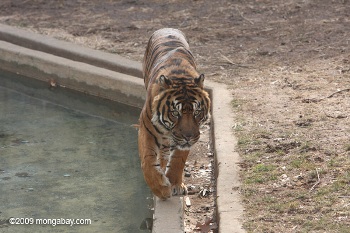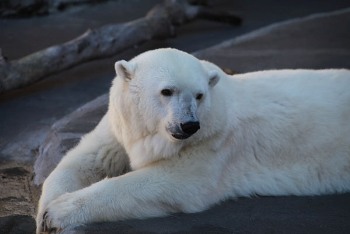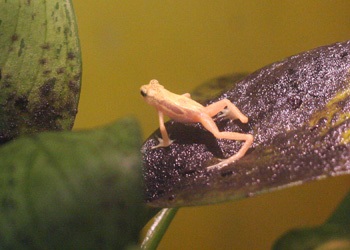In June a German court handed down a guilty verdict to the Magdeburg Zoo director, Kai Perret, and three employees for euthanizing three tiger cubs in 2008. The zoo decided to kill the cubs when it was discovered that the cubs’ father was not a 100 percent Siberian tiger (i.e. he was a mix of two different subspecies). This is generally standard practice at many zoos around the world as animals that are not ‘genetically pure’ are considered useless for conservation efforts. However, the court found the workers guilt of breaking animal rights laws, finding that there was “no sufficient reasons to kill less valuable, but totally healthy animals.”
“The judge was right,” Craig Redmond, campaigns director of the Captive Animals’ Protection Society told mongabay.com. “If there was no strong veterinary reason for killing the animals (e.g. they were too sick to survive) then what are the reasons for killing? In these cases it’s really about economics—zoos do not want to have to spend money on animals they believe have no worth. Why pay to house and feed those animals, having to perhaps build new enclosures to house extra animals, when that space could be used for another souvenir kiosk?”
A statement by World Association of Zoos and Aquariums (WAZA) supports the decision by the Magdeburg Zoo to put the tiger cubs to sleep, calling it “reasonable” and “scientifically-supported action”. With the purpose of safe-guarding a “viable” captive population of endangered species, zoos must sometimes make difficult decisions according to WAZA.
 Captive Sumatran tiger. Photo by: Rhett A. Butler. |
“[Conservation] management takes on many forms and can, on occasion, include the euthanasia of individuals. Humane euthanasia, as a component of population management, and based on scientific analysis of the ex situ (i.e. captive population) to ensure its long-term sustainability, is supported by WAZA as acceptable,” the statement reads.
Since the three tiger cubs would not be used to breed a future population of tigers, due to being a hybrid of different subspecies, they were seen by the Magdeburg Zoo as not worth the expense, care, and space required to keep alive three of the world’s biggest cats. Animal rights activists see such decisions as deeply immoral.
“We are of the opinion that every animal – no matter if ‘pure bred’ or not—has the same rights,” Nadja Kutscher from People for the Ethical Treatment of Animals-Germany (PETA) told mongabay.com. “Therefore, we consider this a racial discrimination—unfortunately, we know best how dangerous such approaches are and what they can lead to.”
The notion of a hybrid tiger, or mongrel, is an important one in this debate. While there is only one species of tiger, biologists generally recognize six subspecies. Subspecies is a designation made by taxonomists or geneticists, usually based on an animal geographic isolation from another population. Subspecies is itself at times a murky concept: scientists often debate (sometimes for decades) whether a divergent population is a distinct species, a subspecies, or neither. While there are guidelines in distinguishing subspecies, given the complexities of genetics, there are no hard and fast rules as to how far apart a population must be from another before it becomes a subspecies or species.
 Another common animal in the zoo that has led to ethical issues: the polar bear. Photo by: Rhett A. Butler. |
In captivity, where tigers of different subspecies were in the past housed together, they bred readily. However, given that most conservationists would be hesitant—to stay the least—to release a mixed-subspecies individual into a wild population, zoos desire only individuals that have been bred with a single subspecies. Given this, WAZA says that the euthanizing of the tiger cubs—and other hybrid animals—is in line with society’s values.
“In light of the fact that the consumptive and terminal use of both wild and domesticated animals for the purposes of food production and recreation is viewed as being acceptable and reasonable in modern society, this [guilty verdict by the court] can only be regarded as an act of legal and moral hypocrisy,” WAZA wrote.
For Kutscher the element of ‘pure-bred’ or not isn’t the point. “A not-pure bred animal is still healthy and experiences love, joy and sadness like a pure bred animal.”
None of the zoo workers included in the guilty verdict face jail time, but the director must pay a fine of 8,100 Euros.
The purpose of zoos?
The euthanizing, lawsuit, and guilty verdict can be seen as an example of a current debate going on between proponents of captive breeding for conservation and animal rights activists, who view keeping animals in captivity as inherently cruel and zoos as exploiting animals rather than saving them. In this debate zoos see themselves as the last safeguards of species vanishing across the world, while animal rights groups see themselves as protecting individual animals from a range of abuses.
 Having gone extinct in the wild, the Kihansi spray toad only survives in captivity. Photo by: Rhett A. Butler. |
To Kutscher zoos serve little real purpose in society and should be phased out with breeding of captive animals ended.
“Only a few parks (e.g. bear parks) should continue to exist to take in traumatized wild animals, for example once wild animals will be banned from circuses. ‘Scientific’ breeding in zoos can be compared to animal testing,” Kutscher told mongabay.com.
While it took zoos a long time to recognize that they could play a role in conservation, during the past few decades a number of zoological institutions have worked actively in aiding endangered species through captive breeding, as well as aiding research, starting novel programs, and focusing more on conservation education. For example the Zoological Society of London (ZSL) a few years ago started one of the most innovative conservation programs in the world, EDGE (which stands for Evolutionary Distinct and Globally Endangered) works with species specifically based on their uniqueness and threat-level—not popularity. In other words the organization works to save species and habitats that big conservation groups have long neglected.
Re-introducing captive animals into the wild can be notoriously difficult, there have been success stories. One of these is the golden lion tamarin, which has bounced back from the brink of extinction after zoos worldwide bred and raised the animals for a reintroduction program in Brazil. Others are on the waiting list: the scimitar oryx, which went extinct in the wild, is currently awaiting planned reintroductions. For a number of amphibian species, captive populations in zoos have become their last stand after they have been wiped out in the wild. All of these animals may have vanished entirely if not for captive breeding. In addition, more zoos are providing funding to conservation programs in the wild. But critic argues that zoos as a whole are doing far too little for conservation efforts and that zoos’ main goal is still largely to breed charismatic animals for entertainment purposes.
 The golden lion tamarin has been successfully reintroduced into the wild aiding its population. Photo by: Rhett A. Butler. |
“You have to consider the reasons why these animals are being bred—and killed—in zoos,” says Redmond. “The zoos would argue that they provide a safe haven for endangered species to breed and ensure the species survives, even if eventually wiped out in the wild, for possible release one day in the future. Yet many conservation scientists consider captive breeding to be a diversion from the reasons for a species’ decline, giving ‘a false impression that a species is safe so that destruction of habitat and wild populations can proceed.'”
Redmond points to a 1996 study in Conservation Biology entitled “Limitations of Captive Breeding in Endangered Species Recovery” as evidence, which looks at the incredible difficulties in successfully reintroducing captive animals in the wild.
“Captive breeding should be viewed as a last resort in species recovery and not a prophylactic or long-term solution,” concludes the study.
Given this, Redmond adds that one of the major problems facing zoos is the opposite of what faces many wild populations: too many animals.
“Breeding animals in zoos inevitably leads to a ‘surplus’ in captivity as animals are rarely released into their natural habitats. This ‘surplus animal’ problem is one of the biggest issues zoos face. Our own research shows that at least 7,500 animals—and possibly as many as 200,000—in European zoos are ‘surplus’ at any one time. This leads to the decision to kill many of them or sell them to exotic pet dealers.”
Investigations have also found that some of these ‘surplus animals’ are sold to game farms and hunting ranches where they are killed for trophies.
Both Redmond and Kutscher argue that the focus should be on conserving animals in the wild not in zoos.
“Conservation is about protecting and restoring natural habitats for all the fauna and flora inhabiting it, not just one or two characteristic species,” Redmond says.
Yet animal rights groups could also be criticized for focusing on the ‘charismatic’ species over others. With so many animals being sold or killed worldwide by zoos, it’s interesting to note that the one incident that attracts both media and legal attention is the death of three tiger cubs, not, say, the death of boa constrictors or bats or tarantulas. Of course, zoos, animal rights groups, conservationists and the media could all be blamed for pandering to public popularity in regards to the world’s biodiversity.
 Panda bear at a zoo. Photo by: Rhett A. Butler. |
While the goal of saving animals in the wild is one all conservationists would be delighted to see succeed, the reality is that wild habitats are being lost with astounding speed and species are facing a wide-variety of threats even in protected areas—from climate change to pollution to poaching for bushmeat and traditional medicine—that are not going to disappear anytime soon. Even once abundant species are seeing large-scale population crashes. With the human population rising above 6 billion and even the most remote wild areas being eyed by governments and corporations for natural resources, the world’s biodiversity is on a downward slope. In the midst of an extinction crisis, zoos say they serve an important role in keeping at least some species from vanishing entirely. But animal rights activists say that zoos are not the solution but a distraction.
The difference may be one of perspective: zoos argue that the end (i.e. saving species) justifies the means (in this case euthanizing individuals), while animal rights activists argue for the recognition of an animal’s individuality. Zoos, along with many conservationists, see threatened populations, but animal activists see a threatened animal.
If zoos were abolished, as some animal rights activists argue, would we lose species that could have been saved? Would conservation education or awareness suffer or improve?
Yet, if zoos continue to be apart of society, as is likely for the time being, do they have the right to make life and death choices for animals in their care?
“Any zoo breeding animals has to take responsibility for those individuals,” says Redmond. “Obviously it would be better for no animals to be bred in zoos, but in this case the zoo should have recognized it either needed to find a suitable home [for the tiger cubs] (and cover the costs for raising those cubs) or provided for them at the zoo. Killing was just the easier and cheaper option.”
In this case, at least, it seems that German court system agrees with Redmond. Whether or not this ruling affects the way zoos operate in Germany or elsewhere remains to be seen.
Note: Mongabay.com contacted several zoological organizations for comment on this piece, including WAZA, but all declined.
Related articles
Endangered Animals: 10 Reasons for Hope

(08/03/2010) Earlier last month the Zoological Society of San Diego launched two far reaching media and development projects which showcase the Zoo’s extensive global field conservation programs. Mongabay had the opportunity to attend the launch ceremony of the Zoo’s new ‘Global Action Team’ and the accompanying ‘Ten Reasons for Hope’ campaign. While at this event, we spoke with Alan Lieberman, Director of Regional Conservation Programs, about the development of both projects.
Captive orangutans: enriching bodies, minds, and lives

(07/22/2010) Visitors to the Orangutan Care Center and Quarantine (OCCQ) are always delighted by the sight of playful young orangutans. Hairy orange youngsters swinging through the branches or tossing balls around always induce fits of cooing and camera clicking. These activities appear to be so natural that it is easy to forget these are orphans in rehabilitation school and one of the main classes is Enrichment. The term enrichment has become a catchword in the world of captive animal husbandry in the past few years and for many organizations, enrichment has become a new focus as more and more research reveals how critical enrichment is to the physical, mental, and emotional wellbeing of captive animals.
Bronx Zoo puts ‘extinct’ frogs on display
(02/02/2010) The Bronx Zoo has a put a most unusual frog on display: the Kihansi spray toad. For one thing, the Kihansi spray toad survived on only 5 acres in the Kihansi gorge in Tanzania, adapted to the areas’ unique and constant mist from the gorge and a waterfall. For another, female Kihansi spray toads give birth to live young, instead of laying eggs. Finally, the Kihansi spray toad is extinct—at least in the wild.